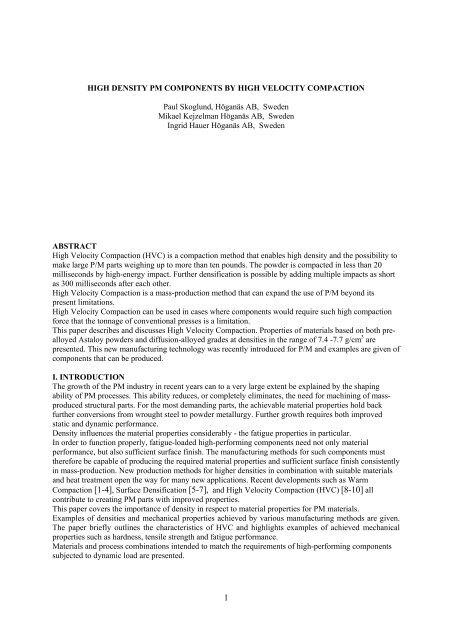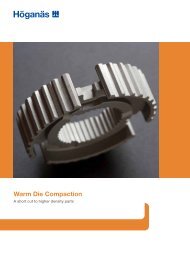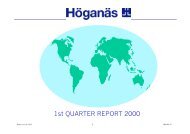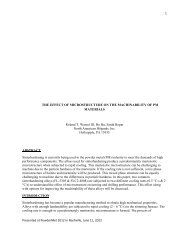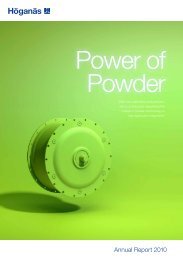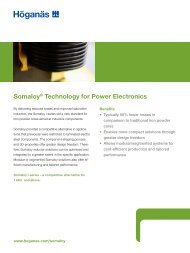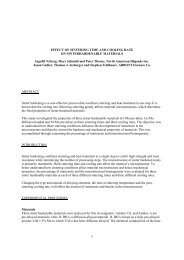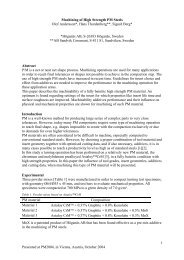high density pm components by high velocity ... - Höganäs AB
high density pm components by high velocity ... - Höganäs AB
high density pm components by high velocity ... - Höganäs AB
You also want an ePaper? Increase the reach of your titles
YUMPU automatically turns print PDFs into web optimized ePapers that Google loves.
HIGH DENSITY PM COMPONENTS BY HIGH VELOCITY COMPACTION<br />
Paul Skoglund, <strong>Höganäs</strong> <strong>AB</strong>, Sweden<br />
Mikael Kejzelman <strong>Höganäs</strong> <strong>AB</strong>, Sweden<br />
Ingrid Hauer <strong>Höganäs</strong> <strong>AB</strong>, Sweden<br />
<strong>AB</strong>STRACT<br />
High Velocity Compaction (HVC) is a compaction method that enables <strong>high</strong> <strong>density</strong> and the possibility to<br />
make large P/M parts weighing up to more than ten pounds. The powder is compacted in less than 20<br />
milliseconds <strong>by</strong> <strong>high</strong>-energy impact. Further densification is possible <strong>by</strong> adding multiple impacts as short<br />
as 300 milliseconds after each other.<br />
High Velocity Compaction is a mass-production method that can expand the use of P/M beyond its<br />
present limitations.<br />
High Velocity Compaction can be used in cases where <strong>components</strong> would require such <strong>high</strong> compaction<br />
force that the tonnage of conventional presses is a limitation.<br />
This paper describes and discusses High Velocity Compaction. Properties of materials based on both prealloyed<br />
Astaloy powders and diffusion-alloyed grades at densities in the range of 7.4 -7.7 g/cm 3 are<br />
presented. This new manufacturing technology was recently introduced for P/M and examples are given of<br />
<strong>components</strong> that can be produced.<br />
I. INTRODUCTION<br />
The growth of the PM industry in recent years can to a very large extent be explained <strong>by</strong> the shaping<br />
ability of PM processes. This ability reduces, or completely eliminates, the need for machining of massproduced<br />
structural parts. For the most demanding parts, the achievable material properties hold back<br />
further conversions from wrought steel to powder metallurgy. Further growth requires both improved<br />
static and dynamic performance.<br />
Density influences the material properties considerably - the fatigue properties in particular.<br />
In order to function properly, fatigue-loaded <strong>high</strong>-performing <strong>components</strong> need not only material<br />
performance, but also sufficient surface finish. The manufacturing methods for such <strong>components</strong> must<br />
therefore be capable of producing the required material properties and sufficient surface finish consistently<br />
in mass-production. New production methods for <strong>high</strong>er densities in combination with suitable materials<br />
and heat treatment open the way for many new applications. Recent develo<strong>pm</strong>ents such as Warm<br />
Compaction [1-4], Surface Densification [5-7], and High Velocity Compaction (HVC) [8-10] all<br />
contribute to creating PM parts with improved properties.<br />
This paper covers the importance of <strong>density</strong> in respect to material properties for PM materials.<br />
Examples of densities and mechanical properties achieved <strong>by</strong> various manufacturing methods are given.<br />
The paper briefly outlines the characteristics of HVC and <strong>high</strong>lights examples of achieved mechanical<br />
properties such as hardness, tensile strength and fatigue performance.<br />
Materials and process combinations intended to match the requirements of <strong>high</strong>-performing <strong>components</strong><br />
subjected to dynamic load are presented.<br />
1
II. IMPORTANCE OF DENSITY<br />
The importance of <strong>density</strong> on the properties of PM materials is paramount. See Figure 1. This study<br />
focuses on the potential growth achievable <strong>by</strong> improved mechanical properties and therefore only <strong>density</strong><br />
levels above 7.0 g/cm3 are of interest. Numerous references cover the importance of <strong>density</strong> in powder<br />
metallurgy. [11-14]<br />
The main reason why PM materials with the same structure as a corresponding wrought material show<br />
lower properties is the presence of pores that simply reduce the load-carrying area and increase the local<br />
stress in the material.<br />
However, for most of the properties, strengthening the matrix with well-designed metallurgy/structure can<br />
compensate for the porosity-related drop in performance.<br />
In the case of properties such as toughness and fatigue strength, pores can initiate cracks.<br />
The size and shape of the largest pores are examples of factors that limit fatigue performance.<br />
Properties , % of theoretical maximum<br />
100%<br />
80%<br />
60%<br />
40%<br />
20%<br />
Density g/cm3<br />
6.4 6.6 6.8 7.0 7.2 7.4 7.6 7.8<br />
Tensile strength<br />
Fatigue strength<br />
Elongation<br />
0%<br />
80% 85% 90% 95% 100%<br />
Relative Density<br />
Figure 1. Principal materials properties relation to <strong>density</strong> for sintered ferrous steel<br />
Materials-related factors that influence the fatigue performance are listed in Table 1.<br />
Traditionally the trend towards <strong>high</strong>-fatigue performance focuses on minimizing the porosity and<br />
optimizing the structure of the matrix. Other significant factors for fatigue performance are residual<br />
stresses and impurities (size and shape). Residual stress can be both positive and negative. If residual<br />
stresses increase total stress, they reduce fatigue performance.<br />
Table 1. Materials-related factors that influence fatigue performance<br />
• Porosity<br />
• Microstructure<br />
• Residual stresses<br />
• Impurities<br />
Residual stresses achieved intentionally <strong>by</strong> surface rolling, shot-peening or case-hardening generally<br />
improve fatigue performance considerably. Increasing efforts are being made in component design and<br />
subsequent processing, which lead to material improvements locally in the most loaded areas.<br />
Powder cleanliness with respect to impurities (i.e inclusions) in standard <strong>high</strong>-quality atomized powder<br />
materials is in most cases not considered a limiting factor, except for extreme applications subjected to<br />
very <strong>high</strong> load.<br />
2
Besides the above, other component-related factors such as surface finish and notch sensitivity are of<br />
importance.<br />
III. HIGH DENSITY TECHNOLOGY<br />
The maximum achievable <strong>density</strong> has been steadily increased in recent years. See Figure 2. Initially,<br />
powders were made more compressible <strong>by</strong> modifying the shape of particles and <strong>by</strong> decreasing carbon,<br />
oxygen and impurity levels. The use of <strong>high</strong>er compaction pressures (600-1000MPa), more efficient<br />
lubricants (Kenolube) and Warm Compaction all lead to <strong>high</strong>er densities. Double Pressing and Powder<br />
Forging have also been developed in order to reach <strong>high</strong>er densities, despite the penalty of <strong>high</strong>er<br />
manufacturing costs. Improved alloying technique was developed to enable better mechanical properties<br />
without compromising on compressibility. Examples of such innovations are diffusion-bonded powders,<br />
which combine robust properties with minimum loss of compressibility, and pre-alloyed powders to which<br />
elements have been added to achieve <strong>high</strong> compressibility and a microstructure that result in <strong>high</strong> strength<br />
(i.e. Astaloy Mo).<br />
Density g/cm 3<br />
7,6<br />
7,4<br />
7,2<br />
7,0<br />
6,8<br />
6,6<br />
SC 100.26<br />
NC 100.24<br />
MH 100.24<br />
ASC 100.29<br />
AHC 100.24<br />
<strong>AB</strong>C 100.30<br />
Kenolube<br />
Warm compaction<br />
6,4<br />
1965 1970 1975 1980 1985 1990 1995 2000<br />
Figure 2. 30 years of <strong>density</strong> improvements in powder metallurgy<br />
The performance of various compaction methods with respect to achievable <strong>density</strong> is indicated in<br />
Figure 3 and Table 2. Conventional compaction is <strong>by</strong> far the most established and frequently used<br />
manufacturing route in powder metallurgy. Double Compaction is also well established, but not so<br />
frequently used, mainly due to the fact that extra manufacturing steps mean <strong>high</strong>er production costs.<br />
Warm Compaction is increasingly used since it typically results in 0.2 g/cm 3 <strong>high</strong>er <strong>density</strong> than<br />
conventional compaction, but without any extra manufacturing steps. Powder Forging of sintered preforms<br />
results in almost full <strong>density</strong> and attractive fatigue properties. This is why Powder Forging, despite<br />
the <strong>high</strong> manufacturing costs caused <strong>by</strong> extra processing, has been successfully implemented for massproduction<br />
of automotive connecting rods.<br />
The combination of selective Surface Densification with the leanest compaction routes presented in Figure<br />
3 can be competitive, not least for gears, since the material can be processed to full <strong>density</strong> locally in the<br />
most loaded areas of the component.<br />
3
The develo<strong>pm</strong>ent of processes, and combinations of processes, that produce <strong>high</strong>er <strong>density</strong>, better surfaces<br />
and more delicate shapes at a lower cost is necessary to ensure growth of the PM industry.<br />
CONVENTIONAL WARM DOUBLE POWDER HIGH VELOCITY HIGH VELOCITY<br />
COMPACTION COMPACTION COMPACTION FORGING COMPACTION DOUBLE<br />
COMPACTION<br />
(P1S1) (WC) (P2S2) (P/F) (HVC) (HVC 2)<br />
POWDER POWDER<br />
powder heating<br />
130<br />
POWDER POWDER POWDER POWDER<br />
o C<br />
COMPACTION COMPACTION COMPACTION COMPACTION COMPACTION COMPACTION<br />
at 130 o C of pre-form <strong>by</strong> impact conventional or HVC<br />
SINTERING SINTERING PRE-SINTER SINTERING SINTERING PRE-SINTER<br />
7.1 g/cm 3<br />
7.3 g/cm 3<br />
Figure 3. P/M manufacturing routes<br />
RE-COMPACTION FORGING RE-COMPACTION<br />
of hot pre-form <strong>by</strong> impact<br />
SINTERING cooling SINTERING<br />
7.4 g/cm 3<br />
A recently introduced manufacturing method that can offer improved properties is High Velocity<br />
Compaction (HVC). Various methods and equi<strong>pm</strong>ent for compaction at <strong>high</strong> <strong>velocity</strong> have been<br />
investigated for almost half a century [15]. Compressed air, combustion of air–fuel mixtures, explosives,<br />
magnets and mechanical springs has been used to create kinetic energy for material forming and powder<br />
compaction. Many of these compaction methods were promising, and some still have potential. Some<br />
have suffered from macro- and micro-cracking of the compacted material caused <strong>by</strong> tensile wave<br />
reflections. This has even been considered a reason for the lack of large-scale commercialization of<br />
dynamic compaction.<br />
The hydraulic impact machine concept is of particular interest for HVC because of its capability to massproduce<br />
<strong>high</strong>-performance PM parts safely and reproducibly. By proper hydraulic control of the<br />
compaction process and adequate powder selection, microstructural defects due to uncontrolled axial<br />
expansion of the green body can be avoided.<br />
IV. HIGH VELOCITY COMPACTION<br />
High Velocity Compaction (HVC) is a powder compaction method that has many similarities to<br />
conventional compaction of PM parts. The most striking differences are that the stage of compaction can<br />
be 500-1000 times faster and that the ram speed of a HVC impact machine can be in the range of 2-<br />
30 m/s. Densification in HVC is achieved <strong>by</strong> intensive shockwaves created <strong>by</strong> a hydraulically-operated<br />
hammer, which transfers the compaction energy through the compaction tool to the powder. The mass of<br />
the hammer and its <strong>velocity</strong> at the moment of impact determine the compaction energy and the degree of<br />
densification. A schematic illustration of the process equi<strong>pm</strong>ent and a graph illustrating the shock waves<br />
are shown in Figure 4.<br />
4<br />
7.8 g/cm 3<br />
7.5 g/cm 3<br />
7.7 g/cm 3
Hammer<br />
Example<br />
m= 115 kg<br />
v = 10 m/s<br />
Compaction<br />
tool<br />
Base<br />
Powder<br />
Compaction <strong>by</strong> Shock waves<br />
Densification is controlled<br />
<strong>by</strong> the Impact Energy !<br />
Figure 4. Basic mechanism of HVC and Hydropulsor HYP35–4 impact machine (4 kJ maximum<br />
compaction energy; 2 950 ft lb) with automatic tool adapter<br />
An interesting feature of HVC is the possibility to perform multiple impacts. In conventional compaction,<br />
the <strong>density</strong> does not increase significantly if the pressing sequence is repeated directly after the initial<br />
compaction. However, using HVC <strong>density</strong> can be increased impact <strong>by</strong> impact. An advantage of increased<br />
densification following multiple impacts, is that it is possible to compact large parts with moderately-sized<br />
equi<strong>pm</strong>ent. Component production <strong>by</strong> HVC consists of the same processing steps as conventional<br />
compaction and the compaction tool design is similar to conventional compaction tools. Good production<br />
economy requires sufficient tool life and it is therefore reassuring that the endurance limit of HVC tools<br />
has been verified to exceed a minimum of 100,000 cycles in a full-scale compaction test [10].<br />
The mechanical properties of P/M materials increase in proportion to the increased <strong>density</strong> achieved <strong>by</strong><br />
HVC. A typical <strong>density</strong> increase of 0.3 g/cm³ has been recorded for <strong>high</strong> <strong>velocity</strong> compacted materials<br />
based on D.AE and Astaloy CrM, compared to <strong>density</strong> levels representative of conventional<br />
compaction. As a result of the <strong>high</strong>er <strong>density</strong>, 20–25% <strong>high</strong>er tensile and yield strengths have been<br />
obtained.<br />
Radial springback of a compact is generally lower for HVC than for conventional compaction. Lower<br />
springback generally leads to the advantage of lower forces being required to eject a part from the die after<br />
compaction. HVC has the capability to produce parts with not only <strong>high</strong> densities, but also very consistent<br />
densities. Compaction tests on prototype gears have shown <strong>density</strong> variations of less than 0.01 g/cm³.<br />
Approximate densities achievable with HVC combined with die wall lubrication (DWL), warm<br />
compaction (WC), and double press, double sintering (P2S2) are presented in Table 2.<br />
5
Table 2. Approximate max densities achieved <strong>by</strong> HVC<br />
Process Density (g/cm³)<br />
HVC 7.4<br />
HVC+DWL<br />
HVC+WC+DWL<br />
7.6<br />
7.7<br />
HVC (P2S2) 7.8<br />
Potential applications for HVC exist both in the automotive industry and in other areas where P/M has not<br />
yet been established. Examples of potential applications are: valve seats, valve guides, main bearing caps,<br />
hubs, gears [8,10], flanges, connecting rods, cam lobes, bushings and bearing races. See Figure 5.<br />
Figure 5. Left: Gear for High Velocity Compaction - courtesy of Cloyes Gears & Products Inc., USA<br />
Right: Gerotor for High Velocity Compaction - courtesy of Hawk Precision Components, USA<br />
Recent R&D in the area of High Velocity Compaction [9] concludes that the major advantages HVC can<br />
offer are: <strong>high</strong> <strong>density</strong>, the capability to compact very large parts, and the possibility to produce <strong>high</strong><br />
numbers of parts in a short time.<br />
V. COMPARISON OF PROCESSING COSTS<br />
Processes that can offer improved material properties with no or moderate increase in manufacturing costs<br />
are of particular interest to the automotive industry, since they can expand the use of P/M applications in<br />
cars and reduce the total cost for the end user.<br />
The approximate relative processing cost for various P/M processes, using conventional single pressing as<br />
a reference, is presented in Figure 6. Production methods that only involve a few processing steps, have a<br />
<strong>high</strong> production capacity and require a minimum of investment for the equi<strong>pm</strong>ent are of special interest.<br />
This applies particularly if net shape or near net shape parts can be produced as a result of good tolerances<br />
and surface finish.<br />
A good cost/performance ratio explains why the conventional compaction method is the most established<br />
and most frequently used. This also explains the recent success of warm compaction, which is increasingly<br />
used and has now spread worldwide.<br />
6
Process:<br />
P1S1<br />
Conventional compaction<br />
WC<br />
Warm Compaction @150 0 C<br />
P2S2<br />
Double Press Double Sintered<br />
PF<br />
Powder Forging<br />
HVC<br />
High Velocity Compaction (P1S1)<br />
HVC 2<br />
High Velocity Compaction (P2 S2)<br />
Figure 6. Relative processing costs<br />
Relative cost<br />
200%<br />
175%<br />
150%<br />
125%<br />
100%<br />
For many <strong>high</strong>-performance applications HVC single compaction is the most attractive from a<br />
cost/performance point of view. Conventional double compaction has been established for many years, but<br />
is limited due to <strong>high</strong> costs. HVC double compaction has a real advantage compared to the conventional<br />
double pressing route because of a much <strong>high</strong>er achievable <strong>density</strong> and the better material properties that<br />
result. Powder Forging is a double compaction step process, in which the final hot compaction step fully<br />
densifies the material. Because of the <strong>high</strong> temperature, the surface finish and tool economy are inferior<br />
compared to the other mentioned processes.<br />
VI. PROPERTIES OF HIGH VELOCITY COMPACTED MATERIALS<br />
The static mechanical strength of various materials obtained from test bars compacted <strong>by</strong> HVC has been<br />
used in order to verify the performance of the material after final processing. Material properties at <strong>density</strong><br />
levels of 7.5 – 7.7 g/cm 3 obtained <strong>by</strong> HVC are presented and compared with the properties achieved <strong>by</strong><br />
other compaction methods that lead to densities ranging from 7-7.4 g/cm 3 . Figure 3 indicates<br />
representative <strong>density</strong> levels for the various compaction methods used. The <strong>high</strong>est <strong>density</strong>, the 7.7 g/cm 3<br />
level, was reached via the HVC P2S2 route. This procedure begin with conventional compaction to<br />
approximately 7.2 g/cm 3 followed <strong>by</strong> pre-sintering and final High Velocity Compaction to target <strong>density</strong>.<br />
For the next <strong>high</strong>est <strong>density</strong>, the 7.5 g/cm 3 level, the HVC P1S1 route with die wall lubrication was used.<br />
Sintering has been performed using a laboratory mesh-belt furnace in a nitrogen-based protective<br />
atmosphere at 1120 o C (2050 o F) for 30 minutes. The cooling rate is 1 o C/s (2 o F/s). Properties originate from<br />
finally processed test specimens produced without any machining. More information about properties of<br />
<strong>high</strong>-performance materials including details on test procedures has been reported recently. [16]<br />
Two materials, Astaloy Mo +2%Ni +0.6%C and Astaloy CrM +0.4%C, were used for determination of<br />
the properties in the as-sintered condition. Both materials are based on fully pre-alloyed water-atomized<br />
iron powders. Astaloy Mo is alloyed with 1.5% molybdenum, Astaloy CrM with 3% chromium and 0.5<br />
% molybdenum. After sintering the Astaloy Mo based material has a metallographic structure containing<br />
75% Bainite, 20% Martensite and 5% Austenite. Metallography on Astaloy CrM showed 70-75%<br />
Bainite and 25-30% Martensite.<br />
Astaloy Mo +2%Ni +0.6%C:<br />
Hardness and tensile properties increase proportionally with increased <strong>density</strong> up to the maximum <strong>density</strong>,<br />
7.7 g/cm 3 . Astaloy Mo +2%Ni +0.6%C reaches a maximum hardness of over 300 HV10 or 27 HRC at a<br />
<strong>density</strong> of 7.68 g/cm 3 . See Figure 7.<br />
7<br />
P1S1<br />
Relative cost vs <strong>density</strong><br />
WC<br />
P2S2<br />
HVC<br />
75%<br />
7,0 7,1 7,2 7,3 7,4 7,5 7,6 7,7 7,8<br />
Density (g/cm3)<br />
HVC 2<br />
PF
HV10<br />
Hardness Vickers and Rockwell<br />
350<br />
300<br />
250<br />
200<br />
150<br />
100<br />
50<br />
0<br />
7,00 7,10 7,20 7,30 7,40 7,50 7,60 7,70<br />
Density (g/cm 3 30<br />
HV10<br />
25<br />
20<br />
HRC<br />
15<br />
10<br />
5<br />
0<br />
)<br />
Figure 7. Mechanical properties of AstaloyMo +2%Ni +0.6%C sintered at 1120 o C (2050 o F) in 90%N2/10%H2<br />
A tensile strength of 980 MPa and a yield strength of 620 MPa was recorded at this <strong>density</strong>. The<br />
corresponding elongation is 4.7%. This is more than three times the elongation value recorded at the<br />
<strong>density</strong> of 7.0 g/cm 3 achieved <strong>by</strong> conventional compaction.<br />
In Figure 8 the bending fatigue life for Astaloy Mo +2%Ni +0.6%C at three <strong>density</strong> levels is shown.<br />
At 7.7 g/cm 3 run-out was achieved at 300 MPa, which is also a great improvement compared with lower<br />
densities.<br />
MPa<br />
400<br />
300<br />
200<br />
100<br />
Bending fatigue limit<br />
8<br />
Four point bending test:<br />
50% fatigue limit<br />
R= -1<br />
Frequency 25 Hz<br />
Run out @ 2 000,000 cycles<br />
Test bar: ISO std 3928 as pressed, sintered and<br />
tempered (no machining)<br />
Figure 7. Bending fatigue limit of AstaloyMo +2%Ni +0.6%C sintered at 1120 o C (2050 o F) in 90%N2/10%H2<br />
Astaloy CrM+0.4%C:<br />
Astaloy CrM +0.4%C also shows considerably improved properties at <strong>high</strong> <strong>density</strong>. At the <strong>high</strong>est<br />
<strong>density</strong>, which is close to 7.6 g/cm 3 , a hardness of 340 HV10 or 33 HRC was observed.<br />
See Figure 9. The tensile strength at this <strong>density</strong> level is 1150 MPa and the yield strength 800 MPa.<br />
HRC<br />
0<br />
7,00 7,10 7,20 7,30 7,40 7,50 7,60 7,70<br />
Density (g/cm 3 )<br />
MPa<br />
Tensile and yield strength<br />
1200<br />
1000<br />
800<br />
600<br />
400<br />
200<br />
0<br />
7,00 7,10 7,20 7,30 7,40 7,50 7,60 7,70<br />
Density (g/cm 3 180<br />
TS<br />
160<br />
140<br />
120<br />
YS<br />
100<br />
80<br />
60<br />
40<br />
20<br />
0<br />
)<br />
ksi
HV10<br />
Hardness Vickers and Rockwell<br />
400<br />
35<br />
350<br />
300 HV10<br />
30<br />
25<br />
250<br />
200<br />
150<br />
HRC<br />
20<br />
15<br />
100<br />
10<br />
50<br />
5<br />
0<br />
0<br />
7,00 7,10 7,20 7,30 7,40 7,50 7,60 7,70<br />
Density (g/cm3)<br />
Figure 9. Mechanical properties of Astaloy CrM +0.4%C sintered at 1120 o C (2050 o F) in 90%N2/10%H2<br />
Astaloy CrM + 0.4%C and D.DH1 +0.6%C as-sinter-hardened<br />
Materials properties can be improved significantly with only a moderate cost increase <strong>by</strong> using sinter –<br />
hardening [17,18]. Previous studies [8] have shown that gears produced <strong>by</strong> HVC and sinter-hardening can<br />
match the properties of gears made from wrought materials. Therefore, a part of this work was devoted to<br />
determining the mechanical properties of two materials suitable for sinter-hardening: Astaloy CrM<br />
+0.4%C and D.DH1 +0.6%C.<br />
D.DH-1 is a water-atomized iron powder containing 1.5% molybdenum (pre-alloyed) and 2% copper<br />
(diffusion-bonded).<br />
Table 3. Properties of sinter-hardened materials at 7.5 g/cm 3<br />
Tensile strength Yield strength Hardness<br />
(MPa) (ksi) (MPa) (ksi) HV10 HRC<br />
AstaloyCrM +0.4%C 1370 191 1230 171 480 44<br />
D.DH1 +0.6%C 1500 208 1190 166 475 46<br />
Sintering:1120 o C 30min 90%N2/10%H2 cooling 5 o C/s (9 o F/s) + tempering 200 o C – air<br />
Astaloy CrM +0.4%C reaches a maximum hardness of 480 HV10 or 44 HRC at a <strong>density</strong> of 7.5 g/cm 3 .<br />
The tensile strength is 1370 MPa and the yield strength 1230 MPa. See Table 3.<br />
For D.DH1 +0.6%C at the same <strong>density</strong>, the corresponding hardness is 46 HRC or 475 HV10. The tensile<br />
strength is 1500 MPa and the yield strength 1190 MPa.<br />
At the <strong>density</strong> level 7.58 g/cm 3 , hardness is 50 HRC for the D.DH1-based material. With even <strong>high</strong>er<br />
densities, optimized carbon content and increased cooling rates during sinter-hardening, hardness values<br />
above HRC 60 can be expected.<br />
Astaloy Mo + 0.2%C as-case-hardened:<br />
Properties suitable for <strong>high</strong> performance gears can be achieved <strong>by</strong> using low-carbon materials, which are<br />
compacted to <strong>high</strong> <strong>density</strong> and then case-hardened after sintering. Case-hardening increases surface<br />
carbon content and the subsequent quenching leads to a hard, fully martensitic surface layer and<br />
compressive stresses. A consequence of the case-hardening is improved performance with respect to root<br />
bending fatigue as well as flank wear. In Table 4, properties in the as-case-hardened condition are<br />
presented. The data originates from pressed and sintered (HVC - P2S2) test bars that have been casehardened.<br />
Carburizing was performed at 920°C for 100 min at a carbon potential of 0.8%C followed <strong>by</strong><br />
HRC<br />
9<br />
MPa<br />
Tensile and yield strength<br />
1400<br />
1200<br />
1000<br />
800<br />
600<br />
400<br />
200<br />
0<br />
7,00 7,10 7,20 7,30 7,40 7,50 7,60 7,70<br />
Density (g/cm 3 180<br />
TS<br />
160<br />
140<br />
120<br />
100<br />
80<br />
YS<br />
60<br />
40<br />
20<br />
0<br />
)<br />
ksi
quenching in oil and tempering at 180°C for 60 min in air. The case depth is 0.5 mm. A hardness profile<br />
and micrographs are presented in Figure 10.<br />
Figure 10. Micrograph and hardness profile for case-hardened test bar. Astaloy Mo+0.2%C @ 7.7g/cm3<br />
A surface hardness of 57 HRC or 790 HV10 was observed at the maximum <strong>density</strong>, 7.7g/cm 3 . The most<br />
striking effect can be seen in the bending fatigue limit that rises to at least 550 MPa. The level of bending<br />
fatigue performance achieved due to the <strong>high</strong> <strong>density</strong> and the case-hardening is of great interest since this<br />
property can be related to the root bending fatigue performance of a gear.<br />
Table 4. Properties of case-hardened Astaloy Mo + 0.2%C<br />
SD Hardness Tensile strength Yield strength Bending fatigue limit<br />
(g/cm 3 ) HV10 HRC (MPa) (ksi) (MPa) (ksi) (MPa) (ksi)<br />
HVC 7,54 730 54 960 134 720 100 Not tested<br />
HVC Double pressed 7,70 790 57 1040 145 805 112 +550* 76<br />
Sintering:1120 o C 30min 90%N2/10%H2; Case-hardened and tempered<br />
* Comment: Upper limit of the fatigue test equi<strong>pm</strong>ent was reached<br />
The relevance of tensile and yield strength values generated from case-hardened test bars can be<br />
questioned since they are not useful in component design. However, they indicate the degree of strength<br />
increase compared to an as-sintered material with the same or similar matrix. A tensile strength in the<br />
order of 1000 MPa was observed for the case-hardened samples.<br />
VII. DISCUSSION<br />
Develo<strong>pm</strong>ent of new <strong>high</strong>-<strong>density</strong> methods expands the potential of powder metallurgy <strong>by</strong> improved<br />
material performance. High Velocity Compacted PM materials can reach very <strong>high</strong> ultimate tensile<br />
strength in combination with <strong>high</strong> ductility. In the experiments described in this paper, tensile strength<br />
exceeding 1000 MPa and an elongation of approximately 5% have been recorded for a FN0206 material.<br />
The combination of <strong>high</strong> <strong>density</strong> and sinter-hardening has proven to offer significant improvement in<br />
mechanical properties. Faster cooling during sinter-hardening, preferably faster than 5 o C/s (10 o F/s) for<br />
production furnaces, would be advantageous since more of the potential of the <strong>high</strong>-<strong>density</strong> materials<br />
could then be utilized. Case-hardened <strong>high</strong>-<strong>density</strong> materials are very attractive for <strong>high</strong>-performing gears<br />
since the hardness and compressive stresses have a potential to significantly reduce flank wear and<br />
improve root bending fatigue performance to levels that can meet the requirements for proper function.<br />
10<br />
HV0,1<br />
Microhardness<br />
Astaloy Mo +0.2%C @ 7.7 g/cm 3 - case hardened<br />
1000<br />
900<br />
800<br />
700<br />
600<br />
500<br />
400<br />
300<br />
200<br />
100<br />
0<br />
0 0,5 1 1,5 2<br />
Distance from surface (mm)
VIII. CONCLUSIONS<br />
As-sintered material properties of <strong>high</strong> <strong>velocity</strong> compacted pre-alloyed materials at densities ranging from<br />
7.5 g/cm 3 to 7.7 g/cm 3 have been determined. These have been compared to the corresponding properties<br />
at <strong>density</strong> levels representative for conventional compaction, warm compaction and the double press<br />
double sinter route.<br />
It has been concluded that the increased <strong>density</strong> levels achieved with HVC result in proportionally <strong>high</strong>er<br />
values for hardness as well as tensile and yield strengths.<br />
Properties of sinter-hardened materials, based on Astaloy CrM and D.DH1, have been determined at<br />
<strong>density</strong> levels exceeding 7.5 g/cm 3 achieved <strong>by</strong> HVC.<br />
The combination of <strong>high</strong> <strong>density</strong> achieved <strong>by</strong> HVC and sinter-hardening makes it possible to produce<br />
stronger materials and use less processing compared to other established manufacturing processes.<br />
Properties of as-case-hardened Astaloy Mo +0.2%C at <strong>density</strong> levels exceeding 7.5 g/cm 3 achieved <strong>by</strong><br />
HVC have been determined.<br />
The properties of this material, including fatigue performance, can match the requirements for <strong>high</strong>-<br />
performance gears.<br />
IX. REFERENCES<br />
1. U. Engström, “High Performance PM Materials <strong>by</strong> Warm Compaction”, PM98<br />
2. U. Engström, B. Johansson, J Rassmus, “Porosity and Properties of Warm Compacted High Strength<br />
Sintered Steels”, PM98<br />
3. U. Engström, “New High Performance PM Application <strong>by</strong> Warm Compaction of Densmix Powders,<br />
Euro PM2000”<br />
4. U. Engström, B. Johansson, “Experience with Warm Compaction of Densmix Powders in the<br />
Production of Complex Parts”, PM2000, Kyoto<br />
5. S. Bengtsson, L. Fordén, S. Dizdar and P. Johansson, Surface densified P/M transmission gear, MPIF<br />
2001 Int. Conf. on Power Transmission Components, October 16-17, 2001, Ypsilanti, MI, USA.<br />
6. Y. Takeya, T. Hayasaka, M. Suzuki, ”Surface rolling of sintered gears”, Met. Powder Rep., 37,<br />
(1982), pp467-470.<br />
7. P.K. Jones, K. Buckley-Golder and D. Sarafinchan, “Developing P/M gear tooth and bearing surfaces<br />
for <strong>high</strong> stress applications”, Advances in Powder Metallurgy and Particulate materials (1997), Vol 1,<br />
pp33-43.<br />
8. P. Skoglund, U.Engström, S.Dizdar “High Density Gears <strong>by</strong> new forming Technology” SAE2002<br />
World Congress, March 2002 Detroit, USA.<br />
9. P. Skoglund, High <strong>density</strong> PM parts <strong>by</strong> <strong>high</strong> <strong>velocity</strong> compaction, Powder Metallurgy Vol. 44 No.3.<br />
2001<br />
10. P. Skoglund, High Density P/M <strong>components</strong> <strong>by</strong> High <strong>velocity</strong> compaction, MPIF 2001 Int. Conf. on<br />
Power Transmission Components, October 16-17, 2001, Ypsilanti, MI, USA.<br />
11. <strong>Höganäs</strong> handbook for sintered <strong>components</strong>, <strong>Höganäs</strong> <strong>AB</strong> 1997.<br />
12. MPIF Standard 35, Materials Standards for P/M Structural Parts 2000 edition<br />
13. MPIF Standard 35, Materials Standards for P/F Steel Parts 2000 edition<br />
14. MPIF Powder Metallurgy Design Solutions, 1999<br />
15. D. Raybould, “On the properties of the of material fabricated <strong>by</strong> dynamic powder compaction”, Proc.<br />
of 7th Int. H. E. R. F. Conf., University of Leeds, Leeds, UK 1981<br />
16. I.Hauer, M.Larsson, U.Engström, “Properties of <strong>high</strong>-strength PM materials obtained <strong>by</strong> different<br />
compaction methods in combination with <strong>high</strong> temperature sintering” PM2002, June 2002 Orlando<br />
USA<br />
17. U. Engström, Evaluation of sintering hardening of different PM materials, PM²Tech 2000, New York,<br />
USA, May 2000.<br />
18. S. Berg, P/M steel suitable for sinter hardening in respect of cost and performance, PM²Tech 2001,<br />
New Orleans, USA, May 2001.<br />
11


